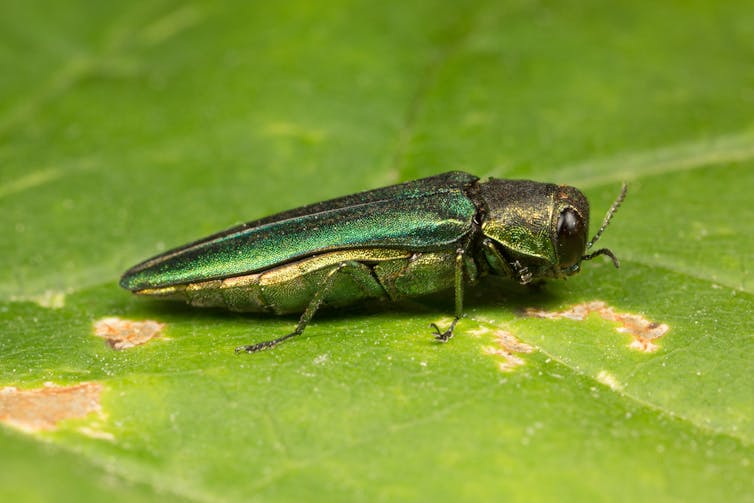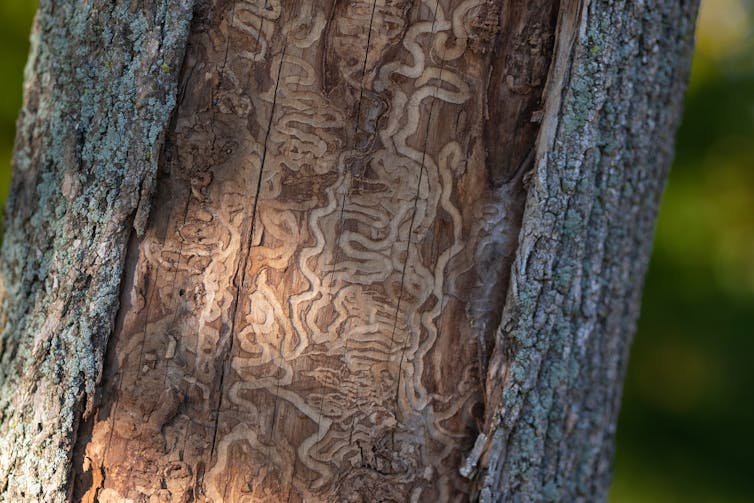The emerald ash borer (EAB) is a deceptively beautiful insect. As the first part of the name implies, the one-centimetre long beetles are an iridescent, metallic green. They have large, dark eyes and some might even call them cute.
But as the second part of its name implies, they are also a prolific pest in North America, where they have killed tens of millions of ash trees.
The insect has recently been found for the first time in Vancouver, seemingly having jumped two provinces to get there from Manitoba — previously the farthest west they had been seen in Canada.
We are entomologists who have 30 years experience in forest insects. Chris MacQuarrie in particular has studied this insect for most of the past 15 years. This arrival is concerning to us.
Invasive import
The emerald ash borer is native to colder parts of East Asia. It likely arrived in eastern North America in the early 1990s by hitching a ride on imported, untreated, wood-packing material.
Many invasive organisms are intercepted at ports by Canadian or American federal inspectors, but the sheer volume of imported material means some pests slip through.
Insects that escape detection often cannot find suitable food or climate conditions in their new home and die out quickly. This was not the case for the emerald ash borer, which can adapt to deep cold and found on arrival a glut of ash trees to gorge upon. In 2002, the pest was first detected, simultaneously, in Detroit, Michigan and Windsor, Ont.

Since then the beetles, which have few natural enemies in North America, have expanded their range to about 36 states across the United States coast to coast primarily centred around the northeast. In Canada, they have moved into Ontario, Manitoba, Québec, New Brunswick, Nova Scotia — and now British Columbia.
Destructive cycle
Emerald ash borer adults emerge from trees in spring. After mating, the females each lay about 50 eggs in the bark crevices of ash trees. The eggs hatch and larvae mine just under the bark where they feed on tree tissues. As winter approaches, they turn deeper into the wood for a few months, returning to feed just under the bark in the spring — the insects mature and emerge as adults after one or two years.
The mining activity of the larvae injures the tree to the extent that it cannot effectively move water and nutrients throughout itself. In essence, the beetle targets the trees’ circulation system.
The first sign of infestation is when the top branches begin to die off. Trees are able to defend themselves, somewhat, but the insect invariably wins.
Asian ash trees evolved to defend themselves against the insect, but North American ashes have only recently encountered it, so they have not had generations to evolve defences. Within a decade of introduction to a new area, almost every ash tree is dead.

A helping hand
While the beetles are potent tree killers, they don’t spread especially quickly on their own — only about 10 kilometres per year if left to their own devices. So how did they seemingly jump hundreds of kilometres to B.C. without being detected in between?
First, it’s possible they are, in fact, already present in Saskatchewan, Alberta or Washington state. Emerald ash borers often live in an area for several years before being noticed. Entomologists now know the insect is in B.C. and will look for it in adjacent jurisdictions moving forward.
Second, while the emerald ash borer and other forest insects get into North America in commercial packing material, once they are on the continent, they often move large distances through domestic transport of wood, such as firewood. Emerald ash borers can complete their life cycle and emerge from firewood-sized pieces of ash, and then infest ash trees in new areas.
Next steps
What can be done to reduce the spread of this invasive pest in B.C.?
British Columbia does not have extensive ash forests, so there are large areas between cities and towns where the insect will find it difficult to spread on its own. Indeed, B.C. has only one native ash species, the Oregon ash that lives on Vancouver Island and the adjacent mainland. This development now means that the Oregon ash trees of Vancouver Island are of conservation concern.
Most of the ash trees in Vancouver and other cities across British Columbia were planted by humans in parks and yards. As such, the only way for the emerald ash borer to move between cities is if people move the infested wood.
The biggest thing you and your neighbours can do is to source and use firewood in the same location.
If you are going camping, get and burn firewood where you are camping and don’t bring it home with you. Don’t give away firewood. If you sell firewood make sure that it is heat treated and kiln dried, which kills the insect inside the wood.
Don’t bring firewood from elsewhere for your wood stove or backyard fire pit. Besides emerald ash borer, many other pest insects move around to new areas this way. It’s never a good idea to move firewood far from where it was cut.
Also, learn the tell-tale signs of emerald ash borer, including dead branches at the top of the tree, damaged bark caused by woodpeckers feeding on the beetle larvae, small D-shaped holes in the trunk where new adults emerge or sprouting branches from the bottom of their trunk. If you notice anything suspicious, report it to the Canadian Food Inspection Agency and your local municipality.
The first report of emerald ash borer in Vancouver came from an observant citizen who reported finding an adult beetle, which eventually led to the detection of the insect in Vancouver’s downtown.
Amid accelerating climate change, all trees — even those that may not be native — play important roles. Unfortunately, the emerald ash borer could kill many of Vancouver’s ash trees over the next few years with significant consequences both in terms of cost and damage to the city’s treescape.
Everyone should play a part! Know the signs of an infested tree, and never move firewood.
Nothing to disclose.
Chris JK MacQuarrie receives funding from federal and provincial governments for his research on emerald ash borer. He is a research scientist with Natural Resources Canada and Past-President with the Entomological Society of Canada.
This article was originally published on The Conversation. Read the original article.







